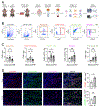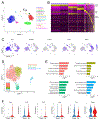CCR2+ monocytes promote white matter injury and cognitive dysfunction after myocardial infarction
- PMID: 38735403
- PMCID: PMC11574971
- DOI: 10.1016/j.bbi.2024.05.004
CCR2+ monocytes promote white matter injury and cognitive dysfunction after myocardial infarction
Abstract
Survivors of myocardial infarction are at increased risk for vascular dementia. Neuroinflammation has been implicated in the pathogenesis of vascular dementia, yet little is known about the cellular and molecular mediators of neuroinflammation after myocardial infarction. Using a mouse model of myocardial infarction coupled with flow cytometric analyses and immunohistochemistry, we discovered increased monocyte abundance in the brain after myocardial infarction, which was associated with increases in brain-resident perivascular macrophages and microglia. Myeloid cell recruitment and activation was also observed in post-mortem brains of humans that died after myocardial infarction. Spatial and single cell transcriptomic profiling of brain-resident myeloid cells after experimental myocardial infarction revealed increased expression of monocyte chemoattractant proteins. In parallel, myocardial infarction increased crosstalk between brain-resident myeloid cells and oligodendrocytes, leading to neuroinflammation, white matter injury, and cognitive dysfunction. Inhibition of monocyte recruitment preserved white matter integrity and cognitive function, linking monocytes to neurodegeneration after myocardial infarction. Together, these preclinical and clinical results demonstrate that monocyte infiltration into the brain after myocardial infarction initiate neuropathological events that lead to vascular dementia.
Keywords: Cognitive; Infarction; Monocyte; Myocardial.
Copyright © 2024 Elsevier Inc. All rights reserved.
Conflict of interest statement
Declaration of competing interest The authors declare that they have no known competing financial interests or personal relationships that could have appeared to influence the work reported in this paper.
Figures








References
-
- Anzai A, Choi JL, He S, Fenn AM, Nairz M, Rattik S, McAlpine CS, Mindur JE, Chan CT, Iwamoto Y, Tricot B, Wojtkiewicz GR, Weissleder R, Libby P, Nahrendorf M, Stone JR, Becher B, Swirski FK, 2017. The infarcted myocardium solicits GM-CSF for the detrimental oversupply of inflammatory leukocytes. Journal of Experimental Medicine 214, 3293–3310. - PMC - PubMed
-
- Bliksøen M, Mariero LH, Ohm IK, Haugen F, Yndestad A, Solheim S, Seljeflot I, Ranheim T, Andersen GØ, Aukrust P, Valen G, Vinge LE, 2012. Increased circulating mitochondrial DNA after myocardial infarction. International Journal of Cardiology 158, 132–134. - PubMed
-
- Bots ML, Breteler MMB, Hofman A, Grobbee DE, van Swieten JC, van Gijn J, van Swieten JC, de Jong PTVM, 1993. Cerebral white matter lesions and atherosclerosis in the Rotterdam Study. The Lancet 341, 1232–1237. - PubMed
MeSH terms
Substances
Grants and funding
LinkOut - more resources
Full Text Sources
Medical
Molecular Biology Databases

